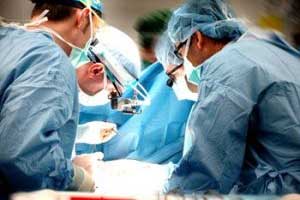- Home
- Editorial
- News
- Practice Guidelines
- Anesthesiology Guidelines
- Cancer Guidelines
- Cardiac Sciences Guidelines
- Critical Care Guidelines
- Dentistry Guidelines
- Dermatology Guidelines
- Diabetes and Endo Guidelines
- Diagnostics Guidelines
- ENT Guidelines
- Featured Practice Guidelines
- Gastroenterology Guidelines
- Geriatrics Guidelines
- Medicine Guidelines
- Nephrology Guidelines
- Neurosciences Guidelines
- Obs and Gynae Guidelines
- Ophthalmology Guidelines
- Orthopaedics Guidelines
- Paediatrics Guidelines
- Psychiatry Guidelines
- Pulmonology Guidelines
- Radiology Guidelines
- Surgery Guidelines
- Urology Guidelines
Self-wearing of gowns by surgeons reduces contamination chances in OT

For surgeons getting ready to enter the operating room (OR), the chances of contamination may be lower if they put their gowns on by themselves - without the assistance of a surgical technician. The experimental study has been published in the Journal of Orthopaedic Trauma.
Contamination occurs in most two-person assisted gowning procedures, suggests the study by Kenton Panas, MD, and colleagues of The University of Oklahoma Health Sciences Center, Oklahoma City. The researchers write, "We suggest a single-person gowning step to help optimize sterile technique in the OR.".
Surgeons Ask, 'Are We Contaminated Before We Cut?'
The researchers designed an experiment to assess possible breaches of sterility during the gowning step before surgery. The study simulated a two-person gowning procedure in which a surgical technician unfolds the gown and holds it open for the surgeon to slide his/her arms through.
The potential for contamination was monitored by coating the surgical technician's gown with a special resin that glows under ultraviolet light. If any of the glowing resin was detected on the surgeon's gown after the procedure, it was considered a contamination event. Three orthopaedic surgeons and three experienced technicians performed a total of 27 gowning procedures.
The results showed evidence of cross-contamination in 67 percent of gowning procedures. All areas of contamination, as shown by glowing of the resin under ultraviolet light, were on the sleeves of the surgical gown.
The surgeons and technicians were selected based on variations in height: in both groups, one participant was tall, one medium height, and one short. The surgeon's height was a significant source of variation, with the tallest surgeon having the greatest amount of contamination of the gown of the sleeve.
The contamination rate was unaffected by technician's height, nor by the surgeon's experience. In fact, the least-experienced surgeon participating in the study had the lowest rate of gown contamination.
Following sterile technique is critical for everyone working in the OR. "Any breach of sterile technique can lead to contamination, which ultimately may lead to infection," the researchers write. This is especially important in orthopaedic surgery because of the frequent use of implantable materials. While several OR procedures have been studied to assess their impact on contamination rates, this is the first study to assess the process of putting on surgical gowns.
Cross-contamination of the surgeon's gown is a common occurrence during the standard two-person assisted gowning procedure, the new findings suggest. The risk of contamination appears greater when gowning taller surgeons - possibly because the longer sleeves are more likely to come into contact with the technician's gown.
While acknowledging their study's small size, Dr Panas and coauthors write, "this study identifies a common and overlooked pattern of sterile field contamination." They suggest that a single-person gowning procedure - where the gown is handed to the surgeon, who then puts it on without assistance - can eliminate this source of contamination and help to optimize sterile technique in the OR.
"Postoperative infections can be life changing in the critically ill and can lead to permanent disability, loss of limb, or worse," Dr. Panas comments. "We hope our work gives surgeons of all specialities one more tool to accomplish our ultimate goal as healthcare providers, which is the optimization of patient care."

Disclaimer: This site is primarily intended for healthcare professionals. Any content/information on this website does not replace the advice of medical and/or health professionals and should not be construed as medical/diagnostic advice/endorsement or prescription. Use of this site is subject to our terms of use, privacy policy, advertisement policy. © 2020 Minerva Medical Treatment Pvt Ltd